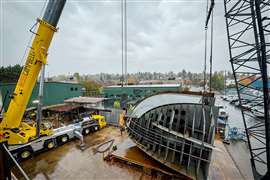Crane association says that ladders may be best
08 May 2012
The Victoria Crane Association, which covers the Victoria region in Australia has issued some important advice to its members on the use of ladders when accessing areas above the ground.
At a recent meeting of the Crane Industry Consultative Committee (CICC), which brings together a wide range of crane industry people, one of the topics discussed was the use of ladders for general construction activity - in particular the practice of working from an A-Frame (step) ladder was noted as becoming unacceptable to a growing number of builders and construction companies.
The CICC said that the use of a wide variety of ladders had been a long time practice for activities such as re-fuelling, setting the fly jib attachments and moving keeper pins while re-reeving hooks .
Some clients are objecting to the use of the ladder supplied with the crane as an acceptable form of access preferring the use of equipment such as mobile lightweight aluminium work platforms - sometimes called a chariot.
The CICC said, "Applying a blanket or generic ban on any specific item or tool is not the way forward for any industry, especially one as specialised and as dynamic as the mobile crane industry. In some instances, where uneven ground or limited space availability is in place, the portable chariots may just not be the best tool for the task.
"The mounting point for access ladders on today's modern range of mobile cranes is typically found in the easiest and most efficient place for use. The ladder is primarily used for accessing the head of the boom and many of these newer cranes have attachment points for both securing the ladder and also for PPE (personal protection equipment) such as harnesses.
It's really important to make sure the tool being used for the task is the right one. Modern high quality mobile cranes have purpose built temporary use ladders fitted from the factory that have positive attachment points to allow the undertaking of specific tasks. The design of these ladders has been carefully incorporated into the entire design of the crane, taking into account transportability issues, manual handling useability and weight issues.
The CICC said that if members were being compelled to use a chariot or other form of generic access equipment for specialised work such as crane rigging, they should speak to their safety representatives or company health and safety managers and discuss other possible safe ways of getting the work done.
"Not every site has perfectly level ground that is suitable for chariots. A specialised rigging ladder that is fit for purpose and secured in accordance with manufacturers' instructions may be a far safer and superior method of doing the task."



